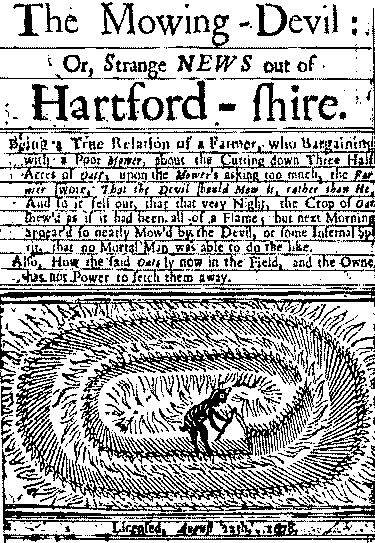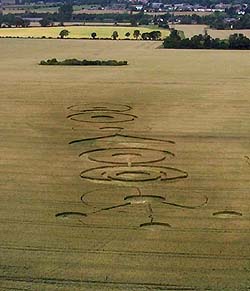Those Mysterious British Crop Circles
by Joanna Emery
 One late summer's day in 1678, an English farmer and a poor mower were arguing over the cost of harvesting the farmer's oat field. Incensed at the mower's proposed price, the farmer swore that the Devil himself should harvest the crop and stomped off. That night, a strange, bright glow lit up the field and, the next morning, the farmer returned to find round circles where the crop had been 'neatly mowed by the Devil, or some infernal spirit'. Each crop stalk had apparently been placed with such 'exactness that it would have taken above an age for any man to perform what he did in that one night'. The event frightened the farmer enough that he subsequently decided to abandon any attempt at harvesting the strange circle. One late summer's day in 1678, an English farmer and a poor mower were arguing over the cost of harvesting the farmer's oat field. Incensed at the mower's proposed price, the farmer swore that the Devil himself should harvest the crop and stomped off. That night, a strange, bright glow lit up the field and, the next morning, the farmer returned to find round circles where the crop had been 'neatly mowed by the Devil, or some infernal spirit'. Each crop stalk had apparently been placed with such 'exactness that it would have taken above an age for any man to perform what he did in that one night'. The event frightened the farmer enough that he subsequently decided to abandon any attempt at harvesting the strange circle.
This description from a woodcut known as the "Mowing Devil or 'Strange News out of Hartford-shire'" is now widely regarding as the first explicit report of a crop circle. Similar accounts have 'cropped up' throughout history leading credence to theories that the crop circle phenomenon is much more than a modern-day fad. In 815 A.D., the Bishop of Lyons wrote of corn flattened by 'magical storms'. While crop circles can occur in any weather, original theories on crop circle formation relate to swirling vortices of ionised air or some other type of natural process similar to ball lighting. Several scientific journals of the nineteenth-century also include references to storms and flattened circles. Another account from 1871 near Plummer's Hill, in High Wycombe, Bucks, describes two disc-shaped objects with flashing lights hovering over a site where the very next day a circle of bent, flattened grasses was discovered.
Tales of unusual light beams, even UFO's, are commonplace around crop circles. While some of these strange lights have been captured on film, perhaps more intriguing are the many oral accounts of crop circle activity from the days before airplanes or secret military technology. Between 1900 and 1910, one woman recalled having seen circles on her grandfather's land near Tilshead, Salisbury Plain. The wheat was apparently 'flattened so firmly that it could not lifted without springing back down.' Some crop circle researchers (know as 'cereologists' after the Roman goddess of agriculture, Ceres) have even wondered if the famous Salisbury Plain megalith, Stonehenge, was itself built to commemorate the spot where a crop circle once formed.
The area certainly has had its fair share of crop circles in recent years. In 1996, the 'Julia Set', a staggering 915 foot long formation with 151 circles, appeared near Stonehenge in broad daylight and within a forty-five minute period. No one had noticed a thing but when news of the miraculous crop circle broke, it attracted over ten thousand visitors within the following weeks.
So what exactly are these crop circles and why are they now such a prominent feature of the English countryside? No one really knows but enough research, however, has been carried out over the last two decades to establish these enigmatic patterns as one of the most awesomeÑand tangibleÑmysteries of our time. Crop circles, also know as agriglyphs and pictograms, have been reported in virtually every country around the globe and in all types of fields, in fact, similar, unexplained patterns have occurred in snow, ice, gravel and even Japanese rice paddies. Since the early 1980's over ten thousand crop circles have been documented with the vast majority appearing in England. The 'hot spot' of crop circle activity happens to be Wiltshire, perhaps because it is the home of ancient sacred sites and mystical monuments such as Stonehenge and Avebury. During the warm summer months, researchers, enthusiasts, even the military, have gathered in the fields of this southern English county to study the intricate and mesmerizing designs of the crop circles. The formations now happen so frequently that special tour buses headed towards the latest crop circle have become a regular sight on the narrow, winding roads of Wiltshire hills.
 Researchers are still baffled by what causes crop circle formations. While skeptics try to dismiss them as elaborate hoaxes, crop circles do exhibit a number of unusual characteristics. For one, they are often not simple circles but beautiful geometric patterns. These include crescent shapes, abstract designs, insect forms, vortex swirls like those in seashells or galaxies. Some represent complex examples of fractals, even mathematical theorems. In 1994, a 'Mayan lunar calendar design' appeared near the ancient Avebury stone circle. Its gradually changing circles were eerily reminiscent of the phases of our moon. In July of 2004, an exquisite 'Chakra' formation occurred in the Vale of Pewsey directly beneath one of the area's chalk White Horses.
Researchers are still baffled by what causes crop circle formations. While skeptics try to dismiss them as elaborate hoaxes, crop circles do exhibit a number of unusual characteristics. For one, they are often not simple circles but beautiful geometric patterns. These include crescent shapes, abstract designs, insect forms, vortex swirls like those in seashells or galaxies. Some represent complex examples of fractals, even mathematical theorems. In 1994, a 'Mayan lunar calendar design' appeared near the ancient Avebury stone circle. Its gradually changing circles were eerily reminiscent of the phases of our moon. In July of 2004, an exquisite 'Chakra' formation occurred in the Vale of Pewsey directly beneath one of the area's chalk White Horses.
Dowsers, and people particularly sensitive to the earth's energy levels, often detect unusual readings within crop circles. The patterns seem to fall on or near invisible energy pathways, or known 'ley lines' across the country. Interestingly, animals will sometimes avoid crop circles while flocks of birds purposely split up rather than fly directly over a formation. The plants stalks within crop circles are not trampled or crushed, a telltale characteristic of many man-made glyphs, but simply bent, leaving the plant undamaged. Microscopic analysis reveals that the plant's crystalline structure has been altered. One possible explanation seems to be some sort of intense burst of heat. What causes it, and whether the source is terrestrial or extra-terrestrial remains to be seen. Coincidentally, the few eyewitness accounts of crop circle formations that do exist describe a large 'ball of fire' lasting for only a few minutes. By morning, a crop circle has occurred in the exact same location. Shades of the 'Mowing Devil' brought up to the present day? Perhaps. One thing is certain... the mystery of the crop circles continues.
More Information:
We regret that we no longer have the resources to maintain up-to-date links and/or hours and pricing details for the various sites and attractions listed on this website. For more information about the location(s) listed above, please use your favorite search engine or visit Wikipedia.
Joanna Emery is an author from Dundas, Ontario and a member of the Canadian Crop Circle Research Network (http://www.cccrn.ca). She has written the first picture book for children featuring crop circles, Crop Circle Quill-Do's.
Article and photos © 2005 Joanna Emery
|
